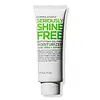Formula 10.0.6 Seriously Shine Free Mattifying Oil Free Moisturizer Versus CeraVe AM Facial Moisturising Lotion SPF30
What's inside
What's inside
 Key Ingredients
Key Ingredients

 Benefits
Benefits

 Concerns
Concerns

 Ingredients Side-by-side
Ingredients Side-by-side

Water
Skin ConditioningPropylene Glycol
HumectantButylene Glycol
HumectantCetearyl Alcohol
EmollientCaprylic/Capric Triglyceride
MaskingDimethicone
EmollientCeteareth-20
CleansingAluminum Starch Octenylsuccinate
AbsorbentSilica Silylate
EmollientBehenyl Alcohol
EmollientPhenoxyethanol
PreservativeDicetyl Phosphate
EmulsifyingCeteth-10 Phosphate
CleansingSalicylic Acid
MaskingPanthenol
Skin ConditioningParfum
MaskingBoron Nitride
AbsorbentBambusa Arundinacea Stem Extract
Skin ConditioningAloe Barbadensis Leaf Juice
Skin ConditioningMaltodextrin
AbsorbentSodium Hydroxide
BufferingWater, Propylene Glycol, Butylene Glycol, Cetearyl Alcohol, Caprylic/Capric Triglyceride, Dimethicone, Ceteareth-20, Aluminum Starch Octenylsuccinate, Silica Silylate, Behenyl Alcohol, Phenoxyethanol, Dicetyl Phosphate, Ceteth-10 Phosphate, Salicylic Acid, Panthenol, Parfum, Boron Nitride, Bambusa Arundinacea Stem Extract, Aloe Barbadensis Leaf Juice, Maltodextrin, Sodium Hydroxide
Homosalate 10%
Skin ConditioningMenthyl Anthranilate 5%
UV AbsorberEthylhexyl Methoxycinnamate 5%
UV AbsorberOctocrylene 2%
UV AbsorberZinc Oxide 6.3%
Cosmetic ColorantWater
Skin ConditioningNiacinamide
SmoothingGlycerin
HumectantCetearyl Alcohol
EmollientBehentrimonium Methosulfate
Dimethicone
EmollientBHT
AntioxidantCeramide NP
Skin ConditioningCeramide AP
Skin ConditioningCeramide EOP
Skin ConditioningCarbomer
Emulsion StabilisingTriethoxycaprylylsilane
Methylparaben
PreservativeSodium Lauroyl Lactylate
EmulsifyingCholesterol
EmollientAluminum Starch Octenylsuccinate
AbsorbentDisodium EDTA
Propylparaben
PreservativeHydroxyethylcellulose
Emulsion StabilisingHydrolyzed Hyaluronic Acid
HumectantPhytosphingosine
Skin ConditioningXanthan Gum
EmulsifyingHomosalate 10%, Menthyl Anthranilate 5%, Ethylhexyl Methoxycinnamate 5%, Octocrylene 2%, Zinc Oxide 6.3%, Water, Niacinamide, Glycerin, Cetearyl Alcohol, Behentrimonium Methosulfate, Dimethicone, BHT, Ceramide NP, Ceramide AP, Ceramide EOP, Carbomer, Triethoxycaprylylsilane, Methylparaben, Sodium Lauroyl Lactylate, Cholesterol, Aluminum Starch Octenylsuccinate, Disodium EDTA, Propylparaben, Hydroxyethylcellulose, Hydrolyzed Hyaluronic Acid, Phytosphingosine, Xanthan Gum
 Reviews
Reviews

Ingredients Explained
These ingredients are found in both products.
Ingredients higher up in an ingredient list are typically present in a larger amount.
Aluminum Starch Octenylsuccinate is a synthetic powder used as an absorbent, thickener, and anti-caking agent.
As an absorbent, it is great at mattifying skin by soaking up the oil. This is why you'll find it in a range of products from makeup to moisturizers.
This ingredient is considered a modified starch. Starch can also be found naturally in plants.
One study from 1991 found that 5% of this ingredient enhanced titanium dioxide SPF by as much as 40%. The study found 1% titanium dioxide had a 5.6 SPF and adding 5% of aluminum starch octenylsuccinate boosted it to an SPF of 8.1
Although “aluminum” in an ingredient name can raise red flags for some consumers, the form and usage context matter significantly. For typical topical applications, there is no substantial evidence of health risks - such as cancer, neurotoxicity, or systemic “aluminum overload.”
Learn more about Aluminum Starch OctenylsuccinateCetearyl alcohol is a mixture of two fatty alcohols: cetyl alcohol and stearyl alcohol. It is mainly used as an emulsifier. Emulsifiers help prevent the separation of oils and products. Due to its composition, it can also be used to thicken a product or help create foam.
Cetearyl alcohol is an emollient. Emollients help soothe and hydrate the skin by trapping moisture.
Studies show Cetearyl alcohol is non-toxic and non-irritating. The FDA allows products labeled "alcohol-free" to have fatty alcohols.
This ingredient is usually derived from plant oils such as palm, vegetable, or coconut oils. There is debate on whether this ingredient will cause acne.
Due to the fatty acid base, this ingredient may not be Malassezia folliculitis safe.
Learn more about Cetearyl AlcoholDimethicone is a type of synthetic silicone created from natural materials such as quartz.
What it does:
Dimethicone comes in different viscosities:
Depending on the viscosity, dimethicone has different properties.
Ingredients lists don't always show which type is used, so we recommend reaching out to the brand if you have questions about the viscosity.
This ingredient is unlikely to cause irritation because it does not get absorbed into skin. However, people with silicone allergies should be careful about using this ingredient.
Note: Dimethicone may contribute to pilling. This is because it is not oil or water soluble, so pilling may occur when layered with products. When mixed with heavy oils in a formula, the outcome is also quite greasy.
Learn more about DimethiconeWater. It's the most common cosmetic ingredient of all. You'll usually see it at the top of ingredient lists, meaning that it makes up the largest part of the product.
So why is it so popular? Water most often acts as a solvent - this means that it helps dissolve other ingredients into the formulation.
You'll also recognize water as that liquid we all need to stay alive. If you see this, drink a glass of water. Stay hydrated!
Learn more about Water